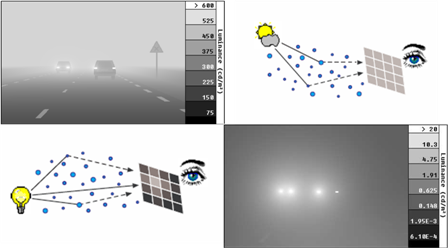| Fog is often considered as a mere nuisance rather than a hazard. However,
reduced meteorological visibility conditions cause accidents and transportation delays, with substantial financial consequences. The visibility loss results from minute airborne droplets which scatter light, causing drastic alterations in the image of the environment perceived by vision systems, both human and artificial. Modeling the visual effects of dense fog makes it possible to simulate foggy conditions, in order to design and test countermeasures for improved safety and mobility. First, we introduce basic notions about the nature of fog and
we briefly review the microphysical models which usually serve to describe its droplet size distribution. Second, we explain how light interacts with fog droplets, and we present the optical descriptors which describe scattering and extinction phenomena. Third, we analyze how contrast is impaired by these phenomena in the image of the environment perceived by a vision system, and we propose and discuss a semi-analytic model of the visual effects of fog. Finally, we show applications of this model to the monitoring of the meteorological
visibility through use of charge-coupled device cameras operating in the visible light range. |



